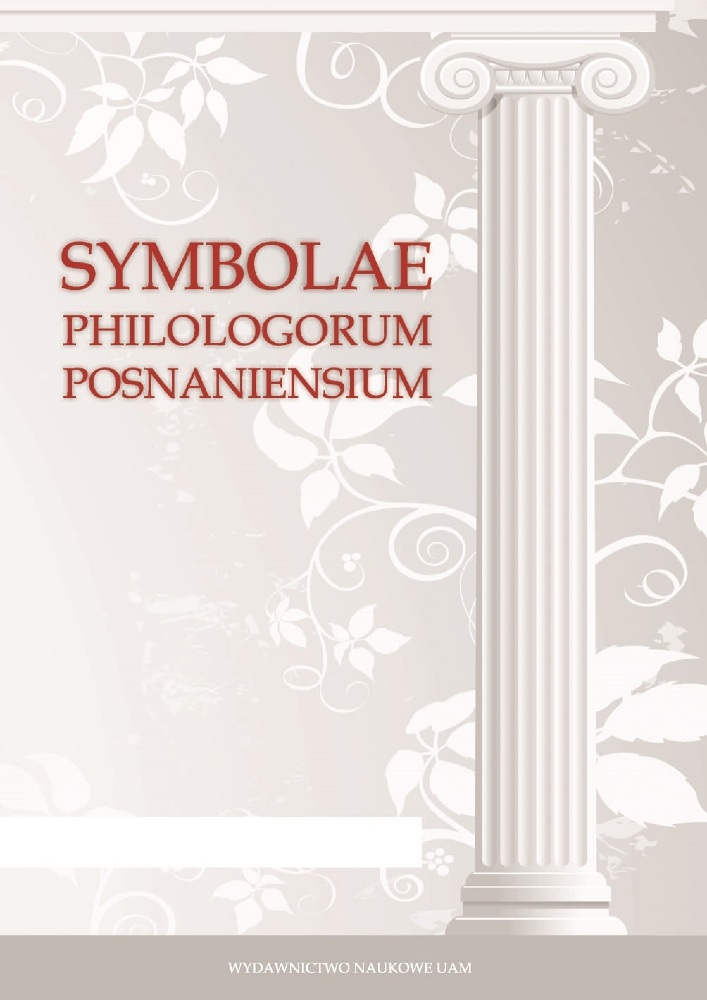Abstrakt
Zbądzki Jakub, Czym była, a czym stała się w renesansie Batrachomyomachia (What the Batrachomyomachia was, and what it became in the Renaissance).The paper presents the Batrachomyomachia as an example of hellenistic poetry and discusses its reception in the Renaissance, when it became very popular, but all its complexity was lost.
Bibliografia
Teksty źródłowe, przekłady, komentarze
Arystofanes, Komedie, t. I, przeł. J. Ławińska-Tyszkowska, Warszawa 2001.
D. Chalkokondyles, Homerus. Opera, Florentia 1488.
M.P. Chatfield, Giovanni Marrasio. Angelinetum and other poems, Cambridge, MA 2016.
J.P. Christensen, E. Robinson, The Homeric Battle of the Frogs and Mice, London 2018.
Homer, Homeric Hymns, Homeric Apocrypha, Lives of Homer, przeł. M. West, Cambridge, MA–London 2003.
Homerika, czyli żywoty Homera i poematy przypisywane poecie, przeł. W. Appel, Warszawa 2007.
P. Melanchthon, Philippi Melanchthonis opera, quae supersunt omnia, oprac. C.G. Bretschneider, t. XI, Hala Saxonum 1843.
C.L. Pasi, De arte grammatica libri octo, Strasburg 1518.
Pseudo-Homer, Batrachomyomachia, przeł. C. Marsuppini, Venecia 1475.
Pseudo-Homer, Batrachomyomachia, przeł. L. Lycius, Lipsiae 1566.
Pseudo-Homer, Batrachomyomachia, przeł. F. Tissard, Paris 1507.
Pseudo-Homer, Batrachomyomachia, przeł. Pseudo-Reuchlin, Vienna 1510.
Pseudo-Homer, Homerus. „Batrachomyomachia”, hoc est bellum ranarum et murium, oprac. L. Valla, Vienna 1516.
Pseudo-Homer, Homeri „Batrachomyomachia”, hoc est, ranarum et murium pugna: graece et latine, Basilea 1518 (wyd. Ioannes Frobenius).
Pseudo-Homer, Homeri „Batrachomyomachia” przeł. J. Münsinger, Friburgum Brisgoviae, 1547.
Pseudo-Homer, „Pugna ranarum et murium” Homeri, przeł. H. Osius, Ratisponae 1566. Pseudo-Homer, Batrachomyomachia czyli Wojna Żabiomysia, przeł. i oprac. W. Appel, Toruń 1993.
Opracowania
Adrados 1998: F. Adrados, History of the Graeco-Latin Fable, Leiden 1998.
Brunner-Traut 1954: E. Brunner-Traut, Der Katzenmäusekrieg im Alten und Neuen Orient, „Zeitschrift der Deutschen Morgenländischen Gesellschaft” 2 (1954), 347–351.
Fonseca 2010: R. Fonseca, A cross-reading of Odysseus’ journey in The Battle of the Frogs and Mice: Psicharpax’s anti-odyssean portrait, „Graeco-Latina Brunensia” 2 (2010), 43–50.
Hernas 1972: C. Hernas, Barok, Warszawa 1972.
Hosty 2014: M. Hosty, The Mice of Ithaca: Homeric Models in Batrachomyomachia, „Mnemosyne” 67 (2014), 1008–1013.
Kelly 2009: A. Kelly, Parodic incosistency: some problems in the „Batrakhomyomakhia”, „The Journal of Hellenic Studies” 1 (2009), 45–51.
Kelly 2014: A. Kelly, Hellenistic arming in the „Batrahomyomahia”, „The Classical Quarterly” 1 (2014), 410–413.
Ludwich 1896: A. Ludwich, Die homerische Batrachomachia des Kares Pigres nebst Scholien und Paraphrase, Lepizig 1896.
Marciniak 2016: K. Marciniak, Our mytical childhood… The Classics and Literature for Children and Young Adults, Boston 2016.
Nichols, Wenzel 1996: S.G. Nichols, S. Wenzel, The Whole Book: Cultural Perspectives on the Medieval Miscellany, Ann Arbor, Michigan 1996.
Pierini 2014: Carlo Marsuppini. Carmi latini. Edizione critica, traduzione e commento, oprac. I. Pierini, Firenze 2014.
Sens 2006: A. Sens, „Τίπτε γένος τοὐμὸν ζητεῖς;”. The Batrachomyomachia, Hellenistic Parody and Early Epic, w: La Poésie épique grecque: métamorphoses d’ un genre littéraire, red.F. Montanari, A. Rengakos, Vandoeuvres-Genève 2006, 215–248.
Van Dijk 1997: G. D. van Dijk, Ainoi, Logoi, Mythoi. Fables in Archaic, Classical, and Hellenistic Greek Literature, Leiden–New York-Köln, 1997.
Wackernagel 1916: J. Wackernagel, Sprachliche Untersuchungen zu Homer,Göttingen 1916.
West 1969: M. West., Near Eastern Material in Hellenistic and Roman Literature, „Harvard Studies in Classical Philology” 1 (1969), 113–134.
Ziomek 2012: J. Ziomek, Renesans, Warszawa 2012.
Licencja

